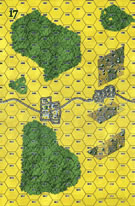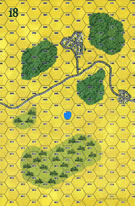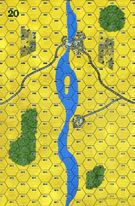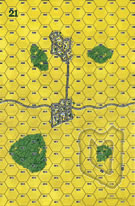|
Killer Koalas Waltzing Matilda #9 |
||
|---|---|---|
| (Attacker) Japan | vs | Australia (Defender) |
| Formations Involved | ||
|---|---|---|
| Australia |  |
2nd Infantry Division |
| Japan |  |
7th Tank Regiment |
| Japan |  |
Imperial Guard Division |

| Total | |
|---|---|
| Side 1 | 1 |
| Draw | 0 |
| Side 2 | 0 |
| Overall Rating, 1 vote |
|---|
|
4
|
| Scenario Rank: --- of 913 |
| Parent Game | Waltzing Matilda |
|---|---|
| Historicity | Alt-History |
| Date | 1942-11-01 |
| Start Time | 07:30 |
| Turn Count | 26 |
| Visibility | Day |
| Counters | 128 |
| Net Morale | 0 |
| Net Initiative | 1 |
| Maps | 6: 1, 17, 18, 20, 21, 3 |
| Layout Dimensions | 86 x 84 cm 34 x 33 in |
| Play Bounty | 204 |
| AAR Bounty | 171 |
| Total Plays | 1 |
| Total AARs | 1 |
| Battle Types |
|---|
| Bridge Control |
| Inflict Enemy Casualties |
| River Crossing |
| Rural Assault |
| Conditions |
|---|
| Off-board Artillery |
| Randomly-drawn Aircraft |
| Scenario Requirements & Playability | |
|---|---|
| Afrika Korps | Counters |
| Eastern Front | Maps |
| Guadalcanal | Counters |
| Road to Berlin | Maps |
| Waltzing Matilda | Base Game |
| Introduction |
|---|
|
Australian Imperial Force soldiers referred to their Militia comrades as "Koalas" - it being illegal to either export or shoot the cuddly marsupial. Militia troops likewise saw no combat and could not leave Australian territory, and the AIF also resented their higher pay scale. But Militia troops did finally see combat in New Guinea and Bougainville, as the government loosened its definition of "Australian territory," proving themselves as capable as the AIF. As they would have had to, had war come to Australia. |
| Conclusion |
|---|
|
Australia had proportionately fewer river barriers than European or Asian battlegrounds, but they would have formed important obstacles where they did exist. Australian forces would have to use every advantage of terrain to delay the Japanese long enough for American assistance to finally break through whatever barriers the Imperial Japanese Navy had interposed. |
| AFV Rules Pertaining to this Scenario's Order of Battle |
|---|
|
| Koalas Show Claws, Can't Hang On |
|---|
|
This is a good-sized river crossing scenario, with the Australians defending and the Japanese attacking. The Aussies set up mostly behind the river, with two companies forward to slow down the Japanese approach. The force was split in thirds between the bridges on either flank and the narrower part of the river in the middle. They were dug-in, but did not have nearly enough troops to cover the entire river. The Japanese split their forces to approach on the two roads, with the heavier force in the north. The Australian speed-bumps blocked the roads temporarily, but were soon overwhelmed by the Japanese armor and infantry. The Japanese came up the roads in a feint toward the bridges, then split off most of their forces to the unguarded sections of the river between the center Australian force and the roads. The Australians were forced to scramble to cover the crossing points, while leaving some troops dug in at the bridges. The Australian artillery (off- and on-board) did a good job of keeping the Japanese engineers disrupted and racking up step losses among the Japanese infantry. The anti-tank guns were less effective. They did get some of the Japanese tanks, but were often disrupted by the Japanese off-board artillery. Once the Australian infantry had shifted to cover the river crossing points, the Japanese in the north shifted their tanks and an infantry company to the town in the north to try to force the bridge there. The Australians in the town were excellent in defense of the town, holding for two hours with few losses while their two-pounders plinked at the tanks from the edges. The Australians were able to choke off the engineer-assisted crossings in the center. At scenario end, only three undemoralized infantry platoons remained west of the river. It looked like the Australians were going to win until the last hour of the scenario. Finally, the Japanese were able to break through the town in the north and cross the bridge with what was left of their tanks and a company of infantry. At the same time, they managed to force the southern bridge with one-and-a-half platoons of tanks supported by more infantry. The final step-loss tally was 41 to 24 in favor of the Australians (tanks counted double). With 8 steps of tanks and 13 steps of infantry across the river and both bridges in Japanese hands, the Japanese earned enough points for a major victory. This was my first river crossing scenario and I really enjoyed it. It was very tense and despite the outcome I do believe it could have gone either way. Before I started adding points at the end I assumed it would be a draw or a very narrow win due to the lopsided step loss totals. I was surprised that the Japanese got a major victory. |
| 0 Comments |

 WaMa008
WaMa008 
































